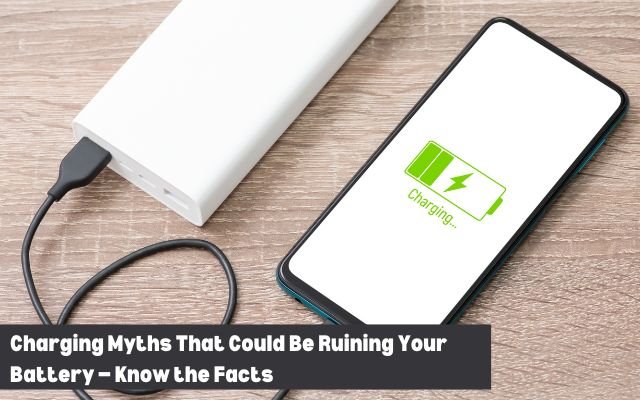Stop Believing These Charger Myths—Learn the Truth
Stop falling for common charger myths! Learn the truth about charging your devices and protect your battery health easily.

We all have a bunch of chargers lying around—whether it’s for our phones, tablets, laptops or other gadgets. But have you ever thought about how much you actually know about these chargers?
Honestly, I didn’t. I used to grab any charger I could find, thinking they all worked the same. There were many things regarding charging that I thought were wrong. My battery life even suffered as a result of some of those errors.
It’s important to stop believing these charger myths. Once I learned the truth I realized how easy it is to avoid common mistakes and keep my devices safe. That’s why I’m sharing these lessons—so you don’t make the same errors I did.
Charger Myths You Should Stop Believing to Protect Your Devices
Are All Third-Party Chargers Bad for Your Device? Here’s the Truth
Many old third-party chargers could damage your battery, but things have improved. Today, certified third-party chargers work well and safely with most devices. For example, I use the Native Union 3-in-1 charger for my phone, smartwatch, and wireless headphones, and I’ve noticed no drop in battery life.
If a charger is certified—like MagSafe for Apple devices—you usually won’t face any issues. In fact, some third-party chargers offer better features or convenience than the original ones.
But it’s important to stay away from the least expensive options. To protect the health of your battery, always make sure the charger is secure and compatible with your smartphone.
Not All USB Chargers Are Safe for Your Devices
Some USB chargers work with different devices. For example, my camera’s USB cable also fits my wireless headphones and bicycle lights. But just because a charger fits doesn’t mean it’s safe to use.
Different chargers have different power outputs. Using the wrong one can damage your device or shorten battery life. I learned this with my LARQ bottle—its charger fits other gadgets, but it’s designed only for the bottle. Even third-party chargers don’t work as well for it.
Always check the charger’s compatibility before plugging it into your devices to avoid damage.
Avoid Fully Draining Your Battery to Protect Its Health
Many people still believe that letting the battery drop to 0% before charging is necessary, but that’s just a common charger myth. In reality, fully draining your battery can harm its long-term health.
You also don’t need to keep your device plugged in all day or wait until it’s completely dead to recharge. For example, imagine not charging your phone before a long trip just because the battery was at 30%—that would be risky and unnecessary.
Instead, it’s better to maintain your battery between 20% and 80%. Charging up to 80% helps extend your device’s battery life by reducing the number of full charge cycles. This simple habit can protect your battery health in the long run.
Do You Really Need to Use a Wall Charger Every Time?
You don’t always need to use a wall charger to power your devices. Many people believe charging your phone or tablet through a computer can damage the battery, but that’s not true. While the charging speed may be slower than a wall charger, it’s still a safe and effective option.
You can also use wireless chargers found in cafes, airports, or even cars. What really matters is the quality of the charger you use—whether it’s a plug, cable, or wireless pad. Always choose a charger compatible with your device to avoid battery issues.
However, be careful when charging in public places. Avoid connecting your device to unknown ports as it could lead to juice-jacking attacks that steal your data.
Is Overnight Charging Really Bad for Your Battery?
Many people avoid charging their devices overnight, thinking it can damage the battery once it hits 100%. But this isn’t true for most modern devices.
Today’s smartphones, tablets, and laptops often come with optimized charging features. For example, Samsung offers Protect Battery mode, while iPhones have Optimized Battery Charging. Many Android devices have similar options. These features stop charging at a certain level to prevent overheating and reduce battery wear.
If you have a newer device, overnight charging is usually safe. Just make sure to enable these features. Still, you can always charge during the day if that feels better for you.
- Avoid These Photo Organization Mistakes to Save Your Precious Memories
- Explore the 5 Best ChatGPT Features You’ll Love
- 5 Hidden Photography Apps I Can’t Live Without
FAQ
1. Can using third-party chargers damage my device?
Answer: Not all third-party chargers are harmful. Certified third-party chargers designed for your device, like MagSafe for Apple, are safe to use. Just avoid cheap, uncertified chargers that could harm your battery health.
2. Is it bad to charge my phone overnight?
Answer: No, charging overnight is safe for most modern devices. Many smartphones have optimized charging features that protect battery health by stopping the charge before it reaches 100%.
3. Should I let my battery drain to 0% before charging?
Answer: No, fully draining your battery can harm its health. It’s better to charge your device when it drops to around 20% and unplug around 80% to extend battery life.
4. Can I charge my phone using my laptop or PC?
Answer: Yes, charging your phone through a computer is safe but slower than a wall charger. Just ensure you’re using a good-quality cable and port to avoid any issues.
5. Does any USB charger work with all devices?
Answer: No, not all USB chargers are safe for every device. Different devices require different power outputs. Always check compatibility to avoid damaging your gadgets.



